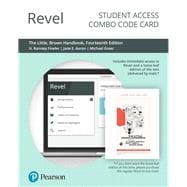For courses in English Composition.
The platinum standard of handbooks¿¿ — unmatched in accuracy, currency, and reliability
The Little, Brown Handbook is an essential reference tool designed to help readers find the answers they need quickly and easily. While keeping pace with rapid changes in writing and its teaching, this meticulous handbook combines comprehensive research and documentation ¿¿with grammar coverage that is second to none. Incorporating detailed discussions of critical reading, media literacy, academic writing, argument, and much more, The Little, Brown Handbook is an accurate, reliable, and accessible resource for writers of varying experience levels and in a variety of fields. The 14th Edition includes over 90 new student samples, new learning objectives, updates to MLA and Chicago style, a new chapter on writing about literature, and more.
Revel is Pearson’s newest way of delivering our respected content. Fully digital and highly engaging, Revel replaces the textbook and gives students everything they need for the course. Informed by extensive research on how people read, think, and learn, Revel is an interactive learning environment that enables students to read, practice, and study in one continuous experience — for less than the cost of a traditional textbook.
NOTE: This Revel Combo Access pack includes a Revel access code plus a loose-leaf print reference (delivered by mail) to complement your Revel experience. In addition to this access code, you will need a course invite link, provided by your instructor, to register for and use Revel.











